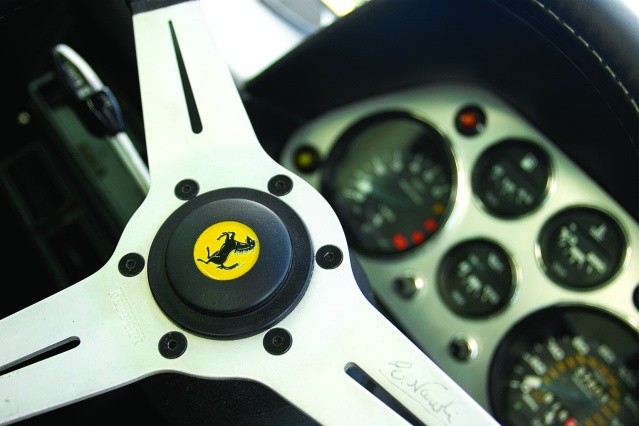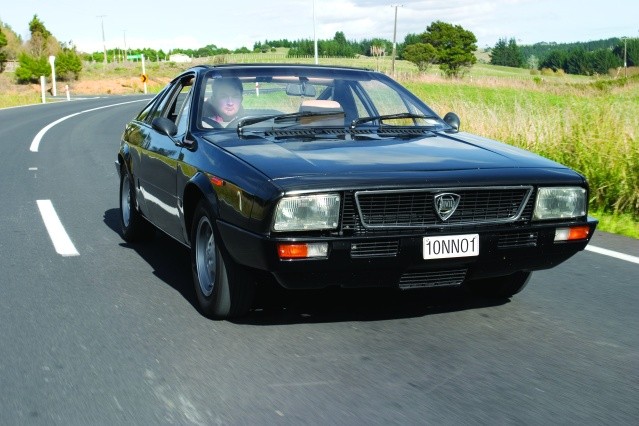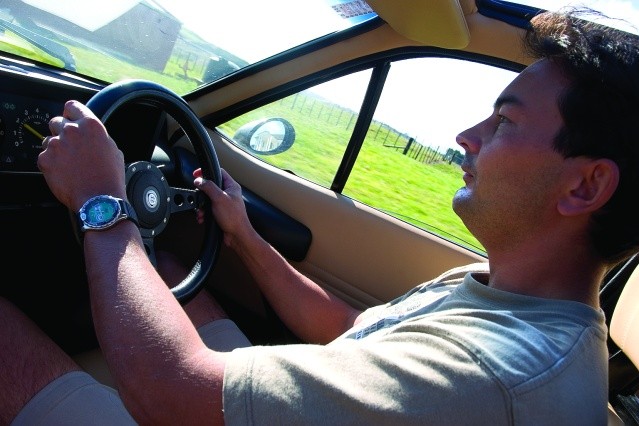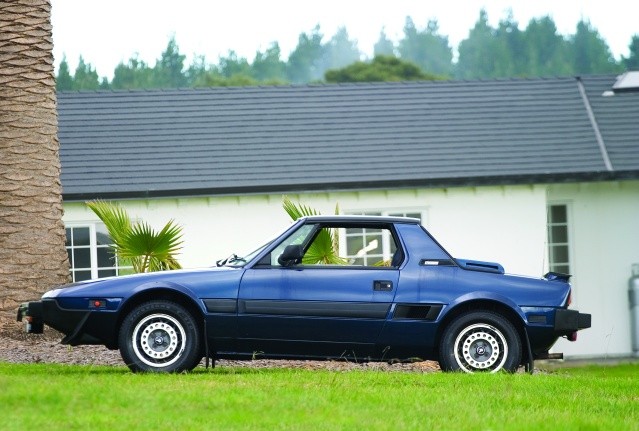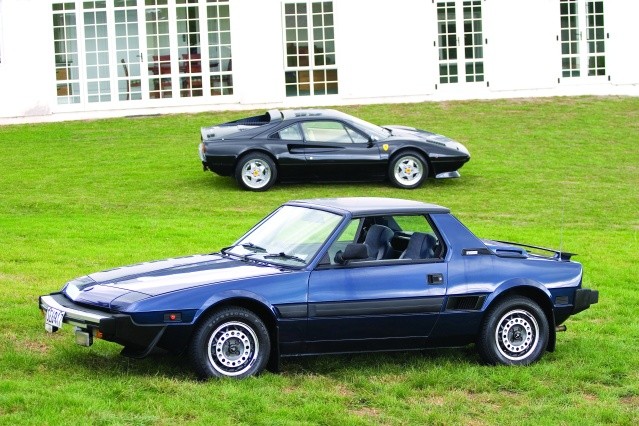data-animation-override>
“Published in New Zealand Classic Car Issue No. 174”

There is something about the way Italians do things which is rather indefinable, but fires admiration in all of us
Just listening to Italians talk, in their own language or someone else’s, prompts a quiet private smile — and car manufacturers the world over use Italian-sounding names for their motor cars to give the product a certain brio.
Brio is an Italian word which in many ways sums up their culture, temperament and designs. Italians are spontaneous, artistic, stylish and apparently carefree, and they are damn good engineers too — you just have to drive along autostradas which tunnel ingeniously through mountains and span deep ravines on beautifully-designed bridges to appreciate they aren’t engineering lightweights.
You have to drive in Italy to understand why Italians design their cars the way they do — they drive their cars, rather than conducting them or using them like an appliance. They actually concentrate on what they are doing. Italian manufacturers must supply a vehicle which responds to that. But it’s their free spirit which endears Italian car designs to us. It is so free that sometimes practical details and reliability get lost in all the brio, but those who love Italian cars quite rightly put that down to character!
The link
It’s a rare car enthusiast who doesn’t secretly dream of owning a Ferrari. Enzo Ferrari insisted he made road cars simply to finance his high-level racing activities. The road cars reflected their racing lineage by being fast and capable, but their price ensured they’d remain the preserve of those who had arrived, rather than those that were getting there.
When the Scuderia went through a lean patch in the mid ’50s, worried Italian motor sport authorities suggested Gianni Lancia should hand his racers over to Ferrari. Lancia had the basis of a great Grand Prix car in his V8 Lancia D50 — but financial problems which precluded racing.
The president of FIAT was persuaded that the prestige of Italy was at stake, and Fiat should contribute. That ‘contribution’ not only resulted in a successful couple of seasons for the Lancia Ferrari D50. It was meant to last five years, but resulted in FIAT eventually taking a controlling interest in Ferrari in the late ’60s. Despite, or maybe because of, its brilliant technical solutions, Lancia continued to founder financially and it, too was swallowed up by FIAT in 1969.
Ferrari 308GTB
Motor racing definitely improves the breed. Major innovations developed through racing usually find their way into production cars — for practical reasons, or simply marketing kudos. At the end of the ’50s, Ferrari’s run of Grand Prix success was halted by the Cooper team, which had adopted the mid-engine layout. Ferrari has tended to be a follower of fashion rather than an innovator, both in racing and production cars. But its first foray with a mid-engined car resulted in a Grand Prix world championship in 1961, and a similar result in 1964.
Famous for its fabulous but expensive front-engined V12 cars, Ferrari decided to go for volume and launched its first production mid-engined car, the Dino 246GT, in 1967.
It was a huge success, and gorgeous too. However, Ferrari saw his competitors achieving higher volumes with 2+2 seating layouts — and thus developed the 2+2 Dino 308GT4, which was announced in 1973.
Designed by Bertone, the 2+2 car was indeed more practical, yet the styling didn’t quite capture the market’s imagination.
But the Pininfarina-designed 308GTB made up for that on its release in 1975. Initially produced with a fibreglass body, the Pininfarina car produced the sales surge Ferrari wanted. As demand went up its body parts were increasingly tooled in steel.
Our featured 1981 all-steel-bodied car is believed to be the last sold with carburettors, rather than fuel injection. This classic shape became one of Ferrari’s all-time best sellers, and survived until 1989 when the 348 came on stream.
FIAT Bertone X1/9
The key to the genesis of the mid-engined volume car was not its ideal weight distribution, but the development of the low cost transmissions needed for bread-and-butter front-wheel-drive cars. The new transmission format was required to put an engine amidships.
BMC’s failure to capitalise on this resulted in one of motoring’s great lost causes. Renault provided the breakthrough for Lotus with its R16 engine. Had Lotus used a BMC unit in its Europa, and if Porsche hadn’t used the VW name for the VW Porsche 914, both cars would have encountered much less customer resistance. And if both manufacturers had adopted less radical styling these basically sound cars might have lead a blazing trail. As it was, FIAT was left to kick start the mass-produced mid-engined trend.
Bertone was keen to produce a budget-priced mid-engined sports car to replace the obsolete 850 Spider he was building for FIAT, and secretly produced a styling study called the Bertone Barchetta Runabout, badged Autobianchi but using a disguised FIAT 128 engine. FIAT was never totally on-side with this project, and without Bertone’s persistence it quite likely would have gone for a rear-drive convertible. However, when American regulations on convertibles looked like turning nasty, Bertone’s ‘targa top’ concept won through.
Though the chassis plates refer to it as a 128 Spyder, the car was released under a prototype name, the X1/9. Affordable mid-engined motoring was available at last — from the same group that produced Ferraris.
When new, the X1/9 was highly praised, but Italian manufacturers were in a period of rust-prone bodies, poorly constructed interiors and unreliable electrics: and the car’s 1290cc engine had a lot of weight to pull along.
A slightly more powerful 1498cc engine was offered from 1978, but in 1981 Bertone took over the X1/9 and the car gained Bertone badges to replace the FIAT ones. Bertone cars were generally better built and appointed, but Bertone didn’t have the resources to fit an engine that would do justice to the car’s potential, so the X1/9, ceased production in 1988 without having fulfilled its sporting promise.
Lancia Montecarlo
Ironically, Lancia was ideally placed to be first with a mid-engined sports car with its narrow angle V4 front-wheel driver from the 1961 Flavia and 1965 Fulvia. However, it wasn’t until years later, after the last Lancia V4, that the FIAT group’s racing needs — and its requirement for a mid-size sports car — called for the X1/20 be drawn up using FIAT’s twin-cam motor.
The Lancia Beta appeared in 1972. FIAT’s idea of what a Lancia should be, it was a respectable design at the time, though clearly not Lancia inspired.
The Beta family soon grew, but the most adventurous Beta variant was the mid-engined Montecarlo Beta, the first idea for which emerged from Pininfarina in 1970. Coded X1/8, it represented a new departure for the coachbuilder as it wasn’t based on any existing production car chassis. Intended as a Fiat 124 Spider replacement and big brother to the impending X1/9, its designation was soon changed to X1/20, and the company worked closely with Abarth to build a 3.0-litre V6 prototype.
Following 1973’s oil crisis, the X1/20 was re-engineered to accept the Beta’s engine and gearbox. Pininfarina designed and built the new car, unveiled at the 1975 Geneva Motor Show. The X1/20 had now become the Beta Montecarlo — named to mark Lancia’s third Monte Carlo Rally victory. Although the Montecarlo’s twin-cam engine derived from the Beta unit, it was the first Lancia to use a new 1995cc configuration — with the engine transversely mounted behind the seats and tuned for 89kW (120bhp). Independent suspension all round was achieved by using MacPherson struts. Oddly, Lancia didn’t use its normal dual circuit braking system, instead opting for a split circuit with servo-assistance on the fronts only — this decision later caused many problems.
The Montecarlo’s reputation was helped by the Montecarlo
Turbo race car’s domination; it won the World Championship for Makes in 1979, ’80 and ’81.
Early Montecarlos were recognisable by solid sail panels behind the cabin, which restricted rear vision. Later cars had glazed buttresses. It was available in either fixed head or spider versions, the latter with a clever folding roof-panel. In 1978 the Montecarlo was suddenly suspended from production, for reasons that weren’t credibly explained. This allowed Lancia to effect much needed modifications. The suspension was retuned to take advantage of new Pirelli P6 tyres; front and rear track was increased by 10mm; and 65-series rubber necessitated a wheel change from the car’s earlier, quite distinctive alloy wheels.
The Beta name was dropped, and Lancia solved the early car’s premature front wheel lock-up by removing the brake servo and fitting slightly larger brake discs. Alas, the revised Montecarlo was dropped in 1981. The Montecarlo is believed to be the first car with a bonded-in windscreen and fibreglass bumpers, the first designed and built by Pininfarina, and its soft top system was so cleverly designed, Pininfarina patented the concept. There are 14 Montecarlos in NZ, but only one running on the North Island.
Ferrari Owners
Peter and Maree Bockett achieved their dream of travelling the world through sheer hard work, and bought their Ferrari in 1996. As Peter says; “It was always our dream to own a Ferrari, we went over to the UK to find one, and having been told the straightest vehicles are selected to have the exterior painted black, that’s what we went for. We looked at 308 GT4s, Mondials, and QVs but realised the 308 GTB suited our expectations.
Our car was British market, registered new in 1981, the last RHD steel-bodied and carburetted 308 GTB built. Its six previous owners — including the Lord Mayor of London — had only completed 25,000 miles [40,233km] in the car altogether.
We brought it back to New Zealand, gave it a bare metal strip and repaint and a full engine rebuild (preventive maintenance), rebuilt the suspension and have carried out the general maintenance and servicing. “We get a huge amount of enjoyment from the car, having taken it to the South Island three times. Never any problems, it is just a dream to drive. We have met many wonderful people via the Ferrari Owners’ Club, all with the same enthusiasm for the marque.”
Fiat Owner
Maree Nicholle is going to Sydney to follow her nursing career, and will soon have to let her beloved X1/9 go. “The story of my 1989 Fiat X1/9 Bertone is rather short. There have only been four owners, including myself, and I’ve had it for the past 12 years. I bought it in December 1993 after I fell in love with the car’s style, and just had to have it. I have never been out of Auckland with it, but it has been my everyday transport for most of this time and it has been extremely reliable, apart from the little electrical problems and regular mechanical maintenance. “It is a great car to drive and the way it looks — do I need to say more? It is absolutely gorgeous, and it always gets noticed when being driven. I love it as it has been my baby but I feel now, after two years of trying to decide, that it is time to let it go, and my circumstances mean I can no longer use it as often as I would like.
Lancia owner
Onno Le Roy caught his father’s infectious enthusiasm for Lancias when growing up in Holland and Belgium. He brought an unfinished Montecarlo over with him when he immigrated to New Zealand, followed by his father who has started the Lancia register here. The car Onno brought is not the one you see here.
“My 1978 car was imported from Hong Kong in ’87; I am the sixth owner since then. My brother Robin spotted it years ago when it was in for service at The Italian Autocentre, in Otahuhu. I immediately drove out there. The car seemed to be in reasonable condition, but had quite a few ‘alien’ parts on it. It was owned by Frank Lester of Waiuku, but it wasn’t for sale.
“In August 2002, a silver Montecarlo was offered for sale at the Lotus dealer in Auckland. I immediately rang, only to hear it had been sold three hours earlier for a price I would have paid within two seconds.
“I felt pretty down and rang Frank Lester. Two days later he rang me, having decided to sell, but first I drove to Hamilton where I bought a trailer load of spare parts from Nelson Marshall, the previous owner of the silver Montecarlo I’d missed.
“My other Montecarlo is a LHD first series with a fixed roof and solid buttresses. Dad bought it in 1990 in Germany, and I brought it to NZ in 1996. It’s still in my garage and will be restored as soon as this black Montecarlo is finished.”
My drives
Three Italian mid-engine coupes, representing three different sizes of the same concept by the same manufacturing group. We also had three levels of preparation — an unrestored daily driver (the FIAT) a part-restored car (the Lancia) and the fully restored Ferrari.
The Fiat was amazingly good considering it had never been restored; yes there were rattles, and the steering wheel leather was losing its colour slightly, but its general condition for its age was absolutely superb.
It was the same with the Lancia; rattle free and beautiful inside, with only a few minor issues to prevent it from being a perfect car.
The Fiat is tiny, and can be hustled about the road just as you like. It’s a nimble, fleet-handling package that is actually screaming out for more power. The 1500cc engine does its job, but a rorty twin-cam in the back would be easy to achieve and would sound magnificent. Tall people have to work their leg around the steering wheel to get in, but once in place it is very comfortable and snug. Everything that is full-size in the X1/9 looks outsize in the cabin, and everything that is brought down to size looks tiny.
The X1/9 is a fun little package, and particularly with this remarkably unspoiled example you don’t have to pay a premium for being different.
Montecarlo
The first surprise about the Lancia was how good the gear change is. Stu’s Trim shop did such a good job on the interior you might think you were already in the Ferrari, but the raucous sports manifold reminds you there’s a four cylinder behind you. It’s such a stylish car inside; the open roof is so completely free of buffeting that you are immediately relaxed and happy.
The great torque and gear change encourage you to make use of the car’s excellent handling, although you must keep your concentration as the brake pedal is well left and lower than the throttle — excellent for heel-and-toeing once you are familiar with the layout. The steering is light and tactile, if a little low geared, but once again this feels like a chassis that could handle much more power.
Ferrari
The Ferrari is just bliss on wheels. It offers a luxurious but understated interior, and each of the controls a tactile delight. The carburettors, superbly set-up recently by Continental Cars, provide no reason for the later car’s fuel injection, and are only noticeable by the lovely induction howl. The engine has as much torque and power as you could practically use, and the gear change is so clean that you have no hesitation about snicking up or down a gear. You don’t need to most of the time, but the noise makes you do it.
Surprisingly, like the other two Italians on test, the Ferrari rides superbly, and the whole car inspires total confidence and feels as comfortable as a supple leather driving glove.
Fiat, Lancia or Ferrari?
No matter what your budget — big or small — one of these mid-engined sports cars should fit the bill. All three are packed to the brim with Italian brio, and each one provides a rather different driving experience from their more traditional, front-engined sports car rivals. As the man once said; you pays your money and you takes your pick — we loved them all.










